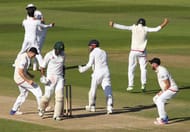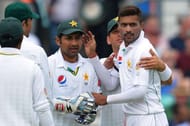Life is, most of the time, lived in nostalgia. The anticipation of the recurrence of an event, that has a significant part of a country’s history etched on it, creates more qualms than the event itself. Hence, quite predictably in the recent past, the questions of cricket’s sanctity being maintained were raised, and so were those related to the game’s acceptability and all-encompassing nature.
“There is one thing that is not in doubt when you discuss Amir – he can bowl,” the English Test captain, Alastair Cook, had said prior to the 1st England-Pakistan Test, about the Pakistani prodigy who was set to make his return to Test cricket at Lord’s – the same place that took the soul out of the home of cricket six years back. “Take away all the off-field stuff he will be a real challenge. The fact is you don’t see many 18-year-olds bowl like he did. He’s an exceptional talent.”
The talk before the walk
This was after Cook had explicitly expressed his opinion about the acceptance of match-fixers – which Amir certainly was – back into the cricketing galleries when he had said that ‘fixers should be banned for life.’ His fellow Englishmen, both friends, and foes had also pitched in with their own quotes on how cricket should deal with such offsprings.
While Graeme Swann, Cook's long-time teammate, had said that Amir's presence at Lord’s would make him feel ‘sick,’ another one of Cook’s teammates, although not on the same page as the aforementioned gentlemen on a whole range of issues, Kevin Pietersen, agreed with them here and said that fixers should ‘not be given a second chance.’
As I said, the anticipation of the event had created more ripples than the event itself. The decision had been made, the punishment had been served, but the customary comments and jibes filled the media in the days leading up to the series.
The players took the field on Day 1, Pakistan batted, Misbah-ul-Haq became the oldest captain in the history of the game to score a Test century – at 42 years of age – and Pakistan went to Stumps at 282/6 in their first innings. The ground was still pure, Swann’s health was intact, and so was cricket’s sanctity. The problems – whether real or farcical, is left to the reader’s judgement – began at the fall of the 8th Pakistani wicket on Day 2, when Wahab Riaz, walking back to the dressing room, crossed ways with Mohammad Amir who strode out to bat in the whites for the first time in six years.
Swann immediately called for an ambulance, Pietersen gave second thoughts about the term ‘second chance,’ and the leader of the pack, Cook, stood in observance, looking at the man who had pulled one of the most remarkable, if not the most remarkable, comebacks that the game had ever seen, all of it at the tender age of 24. Amir scored 12 off 10, with all of those runs coming in boundaries, two off Chris Woakes, and one off Stuart Broad.
His captain, Misbah, who had defied odds at his age, was arrested, finally, by Broad, who four overs later, in the fond remembrance of his career-best 169 that had come on this very ground on that fateful day, got the ‘boy’ caught by Root in the slips. That marked the end of short but eventful first burst that the most talked about cricketer of the series had upon his return from exile.

Amir at Lord’s – a moment to behold
What followed thereafter was a subdued yet promising return by the man (and he can be called a man now) to the whites. Although the better half of Pakistan’s bowling on the Lord’s surface belonged to Yasir Shah, a rather innocuous widish ball meandering outside off took Cook’s extended bat and crashed into the middle stump to give Amir’s his first Test wicket in six years. Cook’s disgust at the shot, which forced him to swipe his bat against the shattered stumps, albeit not damaging them any further, could only be matched by Amir’s trademark celebration of extended arms – Shoaib Akhtar style – with the eyes spitting fire which only he could store underneath.
England’s second innings followed a similar story. The Pakistani leg-spinner, playing only his first Test outside the UAE, bagged a ten-wicket-haul, but the cherry on the cake was to be laid by the poster boy, and deservingly so. Having bowled for 15 overs conceding runs at just over two per over, a full and straight ball angled on middle and leg was what it took for Amir to get his first recognisable impact on the series. As Broad missed, his stumps were rattled, and a few overs later, when a good length ball on leg stump beat Jake Ball’s bat – that was dangling towards oblivion – it was all over. Pakistan had won the Test and it was Amir who won it for them, at least technically.
“It's been a remarkable turnaround after the 2010 incident,” said Misbah after the game. “He's part of the team that has won the Test match, it will be one of the memorable days of his life and from here he can start his career again. He's a good kid now, he's a mature cricketer and he can prove to everyone that he's a good bowler.”
However, a return of 3 wickets for 104 runs from 36 overs didn’t exactly account for a promising comeback. In fact, had he been a debutant, it would have easily been his last Test of the season. But call it the reputation of the man, or the sheer nostalgia associated with him, everyone around the cricketing galleries knew that Amir would take the new ball for the next three Tests.
Old Trafford – England pounce back
And when he did for the second Test – and before Cook and Root took the glory away from the Pakistanis – for a brief moment it looked as if the years had been rolled back, when a delivery swung in towards Hales, and then held its line after it pitched full on just on the middle stump. The distance between the bat and the pad was proportionate to the geographical distance between the two countries, and Mohammad Amir penetrated it with ease.
Cook and Root did what they did thereafter, as Yasir Shah’s wicketless marathon began Old Trafford. Amir got Hales again in the second innings, but England’s lead had already approached 500 by then.
“Maybe there was a bit of tiredness after he bowled a lot of overs in the previous Test," Misbah said of Yasir. "But there was a big difference in this match compared to the previous one. He could not really bowl with that control and consistency.” Nor could any of the Pakistani bowlers in that match. Maybe the victory at Lord’s and the celebration thereafter had still not settled in. Whatever it was, it proved that all England needed was only a window of opportunity.
Edgbaston – so close, yet so far
While Sohail Khan hogged much of the limelight during the third Test at Edgbaston, and Jonny Bairstow and Moeen Ali snatched the victory right out of Pakistan’s hands, Amir struck twice in two overs with the second new ball on Day 1 to get Ali and Broad caught behind the stumps to draw to a close England’s first innings stuttering at 297.
That Pakistan made 400 in their first essay and then went on to lose by 141 runs speaks volumes about Bairstow and Ali’s efforts and Anderson and Broad’s as well, who got the Pakistani captain admit that they were the better exponents of a skill that was grown on his home soil – the reverse swing.
“Anderson and Broad are used to these conditions. They are really experienced. Full credit to England for the way they fought back after we had a lead of more than 100. I think we'll just have to send someone to learn from England now how they're reversing this ball. We could not do it even on the fourth day. I think they are really doing it well,” said Misbah after the game.
Sweet redemption at the Oval
Sohail Khan bagged a five-wicket-haul for the second match in a row – at the Oval – but before he could get his share of the attention, Amir, and by extension, Yasir Shah, got the attention of the crowd and players alike, when a claimed catch at short square leg off Alex Hales could not be judged for its veracity by the third umpire Joel Wilson. Bruce Oxenford, the on-field umpire, who had given it ‘Out’ initially before asking his colleague to have a look was thereby directed to stay with his decision, much to the dismay of a fuming Hales, who was later reprimanded for his aggressive behaviour towards the officials.
Later on, after Sohail’s heroics and Wahab’s little cameo on his comeback, Moeen Ali and Jonny Bairstow were at it again, and after having England 5 down at 110, it seemed as it would be a deja vu from the third Test. However, Amir had other plans, as one of his wide deliveries outside the off stump had enough invitation on it to draw Bairstow forward into the drive and induce an inside edge. That was Amir’s last wicket of the series, and Younus Khan’s routine work of making magnanimous comebacks made sure that Pakistan bowed out with the honours being equalled.
The verdict
So how exactly did Amir fare? 12 wickets across 4 Tests at 42.41 and a strike rate of 81.2 make up for terribly bad numbers. However, it must not be in the light of these statistics that his performances must be judged.
If one observes closely, the pacer got a well-set Cook in the first innings at Lord’s, got Hales at Old Trafford with one of the best deliveries that he bowled all series, got Moeen Ali – who had already made a half-century – on the first day at Edgbaston to help Pakistan wrap up the English tail, and broke the threatening stand between Bairstow and Ali once again at the Oval. Hence, Mohammad Amir on the opening days of each of the four Tests helped Pakistan get a breakthrough when they needed it the most. For a new-ball bowler to do that, especially after returning from an arduous six-year-long break from the whites is an achievement in itself.
This wasn’t Amir’s redemption series – not at least with the ball. He has bowled better in the past and will bowl better than how he bowled in England this summer. But one thing that can be grasped for sure from this performance is the fact that six years of gruelling struggle had only hardened the man even better, and notwithstanding his performances henceforth, Amir’s comeback to Test cricket would remain a folklore to be remembered.
Brand-new app in a brand-new avatar! Download CricRocket for fast cricket scores, rocket flicks, super notifications and much more! 🚀☄️



